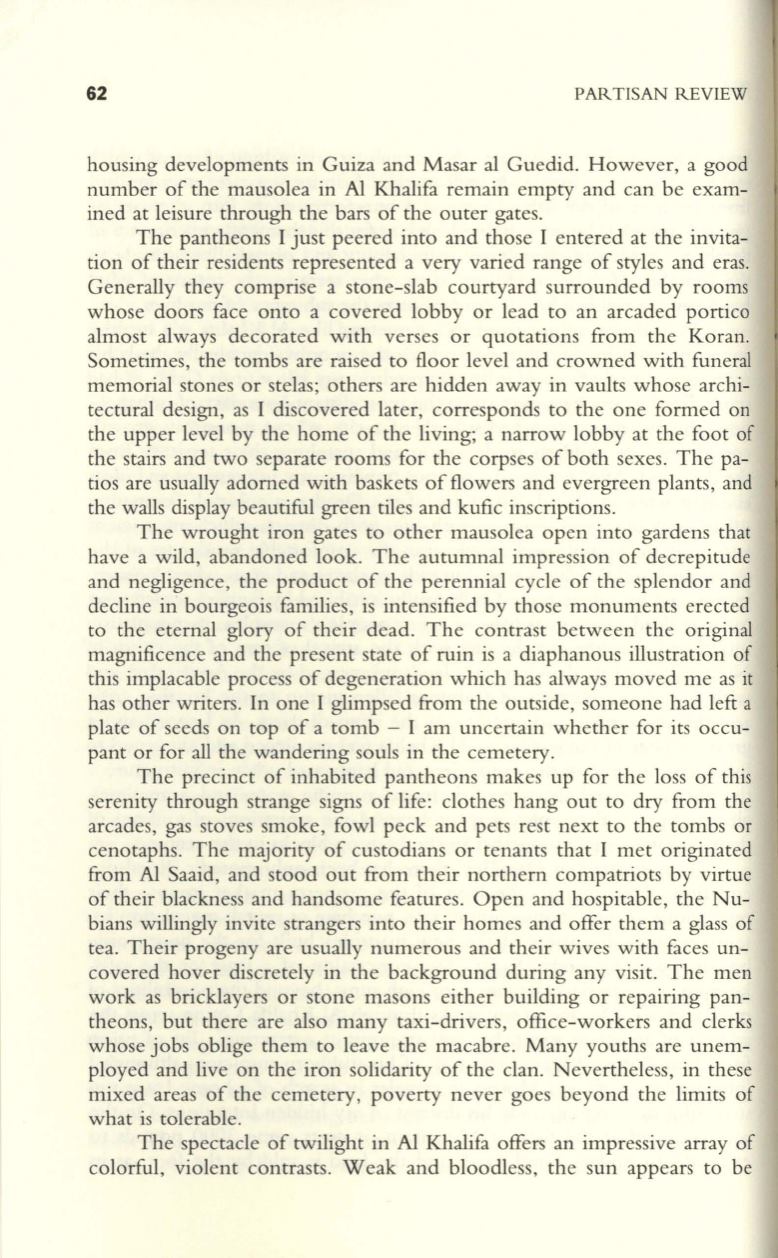
62
PARTISAN REVIEW
housing developments in Guiza and Masar al Guedid. However, a good
number of the mausolea in AI Khalifa remain empty and can be exam–
ined at leisure through the bars of the outer gates.
The pantheons I just peered into and those I entered at the invita–
tion of their residents represented a very varied range of styles and eras.
Generally they comprise a stone-slab courtyard surrounded by rooms
whose doors face onto a covered lobby or lead to an arcaded portico
almost always decorated with verses or quotations from the Koran.
Sometimes, the tombs are raised to floor level and crowned with funeral
memorial stones or stelas; others are hidden away in vaults whose archi–
tectural design, as I discovered later, corresponds to the one formed on
the upper level by the home of the living; a narrow lobby at the foot of
the stairs and two separate rooms for the corpses of both sexes. The pa–
tios are usually adorned with baskets of flowers and evergreen plants, and
the walls display beautiful green tiles and kufic inscriptions.
The wrought iron gates to other mausolea open into gardens that
have a wild, abandoned look. The autumnal impression of decrepitude
and negligence, the product of the perennial cycle of the splendor and
decline in bourgeois families, is intensified by those monuments erected
to the eternal glory of their dead. The contrast between the original
magnificence and the present state of ruin is a diaphanous illustration of
this implacable process of degeneration which has always moved me as it
has other writers. In one I glimpsed from the outside, someone had left a
plate of seeds on top of a tomb - I am uncertain whether for its occu–
pant or for all the wandering souls in the cemetery.
The precinct of inhabited pantheons makes up for the loss of this
serenity through strange signs of life: clothes hang out to dry from the
arcades, gas stoves smoke, fowl peck and pets rest next to the tombs or
cenotaphs. The majority of custodians or tenants that I met originated
from AI Saaid, and stood out from their northern compatriots by virtue
of their blackness and handsome features. Open and hospitable, the Nu–
bians willingly invite strangers into their homes and offer them a glass of
tea. Their progeny are usually numerous and their wives with faces un–
covered hover discretely in the background during any visit. The men
work as bricklayers or stone masons either building or repairing pan–
theons, but there are also many taxi-drivers, office-workers and clerks
whose jobs oblige them to leave the macabre. Many youths are unem–
ployed and live on the iron solidarity of the clan. Nevertheless, in these
mixed areas of the cemetery, poverty never goes beyond the limits of
what is tolerable.
The spectacle of twilight in Al Khalifa offers an impressive array of
colorful, violent contrasts. Weak and bloodless, the sun appears to be


